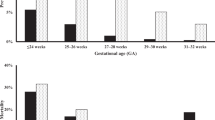Abstract
Background:
Spontaneous intestinal perforation (SIP) is increasingly common in the premature infant and has been demonstrated to be associated with early postnatal administration of glucocorticoids and indomethacin. Before survival of the extremely low birth weight (ELBW) infant, SIP was thought to be a rare, congenitally acquired disease sporadically affecting the muscularis of the distal intestine. These disparate views of etiology have not been previously reconciled in the literature.
Objectives:
(1) To establish a cohort of SIP patients in a national data set. (2) To use timing of diagnosis as a unique data element and thereby differentiate between SIP cases which are susceptible to postnatal risk factors versus those occurring at or immediately after birth (and therefore not exposed to postnatal risk factors).
Methods:
A large deidentified national data set was used to retrospectively look at timing of diagnosis and then the cohort was divided into postnatal treatment groups for further subanalyses. This analysis resulted in the division of the cohort into early and late diagnosis SIP subcohorts. These were then queried retrospectively by univariate analysis to look for differences in demographics between the two (using a P-value < 0.05)
Results:
There were 633 patients with SIP evaluated in this data set. The early SIP cohort (0–3 days) was made up of 116 infants with a median BW of 1.401?kg, whereas the late cohort (4–14 days) held 386 infants with a median BW of 775?g. Infants with early SIP were significantly more likely to: be male, have higher Apgar scores, have not received antenatal steroids, surfactant or required mechanical ventilation.
Conclusions:
Two populations of infants acquire SIP: ELBW infants acquire SIP on average between 7 and 10 days of life after exposure to indomethacin and glucocorticoids (either endogenous or exogenous), and infants with early SIP (0–3 days) who are significantly less likely to have been exposed to postnatal risk factors and are less premature.
This is a preview of subscription content, access via your institution
Access options
Subscribe to this journal
Receive 12 print issues and online access
$259.00 per year
only $21.58 per issue
Buy this article
- Purchase on Springer Link
- Instant access to full article PDF
Prices may be subject to local taxes which are calculated during checkout

Similar content being viewed by others
Abbreviations
- SIP:
-
spontaneous intestinal perforation
- ELBW:
-
extremely low birth weight
- NEC:
-
necrotizing enterocolitis.
References
Attridge JT, Clark RM, Walker WM, Gordon PV . New insights into spontaneous intestinal perforation using a national data set: (1) SIP is associated with early indomethacin exposure. J Perinatol (in press; originally published online Dec 1, 2005, at www.nature.com/jp/journal/vaop/ncurrent/abs/7211429a.html).
Stark AR, Carlo WA, Tyson JE, Papile LA, Wright LL, Shankaran S et al. Adverse effects of early dexamethasone in extremely-low-birth-weight infants. National institute of child health and human development neonatal research network. N Engl J Med 2001; 344: 95–101.
Watterberg KL, Gerdes JS, Cole CH, Aucott SW, Thilo EH, Mammel MC et al. Prophylaxis of early adrenal insufficiency to prevent bronchopulmonary dysplasia: a multicenter trial. Pediatrics 2004; 114: 1649–1657.
Schmidt B, Davis P, Moddemann D, Ohlsson A, Roberts RS, Saigal S et al. Long-term effects of indomethacin prophylaxis in extremely-low-birth-weight infants. N Engl J Med 2001; 344: 1966–1972.
Lloyd JR . The etiology of gastrointestinal perforations in the newborn. J Pediatr Surg 1969; 4: 77–84.
Litwin A, Avidor I, Schujman E, Grunebaum M, Wilunsky E, Wolloch Y et al. Neonatal intestinal perforation caused by congenital defects of the intestinal musculature. Am J Clin Pathol 1984; 81: 77–80.
Izraeli S, Freud E, Mor C, Litwin A, Zer M, Merlob P . Neonatal intestinal perforation due to congenital defects in the intestinal muscularis. Eur J Pediatr 1992; 151: 300–315.
Guthrie SO, Gordon PV, Thomas V, Thorp JA, Peabody J, Clark RH . Necrotizing enterocolitis among neonates in the United States. J Perinatol 2003; 23: 278–285.
Werler MM, Mitchell AA, Hernandez-Diaz S, Honein MA . Use of over-the-counter medications during pregnancy. Am J Obstet Gynecol 2005; 193: 771–777.
Acknowledgements
Dr Gordon was supported by NIH NIDDK Grant 1KO8DK/HD61553-01. We are grateful to Sheryl Mroz and Sarabeth Gordon, MS for their editorial support and to all the caregivers within Pediatrix for their daily attentiveness to the electronic note system.
Author information
Authors and Affiliations
Corresponding author
Rights and permissions
About this article
Cite this article
Attridge, J., Clark, R., Walker, M. et al. New insights into spontaneous intestinal perforation using a national data set: (2) two populations of patients with perforations. J Perinatol 26, 185–188 (2006). https://doi.org/10.1038/sj.jp.7211439
Received:
Revised:
Accepted:
Published:
Issue Date:
DOI: https://doi.org/10.1038/sj.jp.7211439
This article is cited by
-
Early antibiotic exposure in very-low birth weight infants and infection risk at 3–7 days after birth
Journal of Perinatology (2023)
-
Spontaneous intestinal perforation in premature infants: a national study
Journal of Perinatology (2021)
-
Surgical necrotizing enterocolitis in extremely premature neonates is associated with genetic variations in an intergenic region of chromosome 8
Pediatric Research (2018)
-
Barriers to enrollment in a randomized controlled trial of hydrocortisone for cardiovascular insufficiency in term and late preterm newborn infants
Journal of Perinatology (2017)
-
Ultrasound to diagnose spontaneous intestinal perforation in infants weighing ⩽1000 g at birth
Journal of Perinatology (2015)



